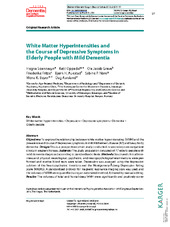| dc.contributor.author | Sønnesyn, Hogne | en_US |
| dc.contributor.author | Oppedal, Ketil | en_US |
| dc.contributor.author | Greve, Ole Jacob | en_US |
| dc.contributor.author | Fritze, Friederike | en_US |
| dc.contributor.author | Auestad, Bjørn Henrik | en_US |
| dc.contributor.author | Nore, Sabine | en_US |
| dc.contributor.author | Beyer, Mona K. | en_US |
| dc.contributor.author | Aarsland, Dag | en_US |
| dc.date.accessioned | 2014-10-01T08:41:55Z | |
| dc.date.available | 2014-10-01T08:41:55Z | |
| dc.date.issued | 2012 | eng |
| dc.identifier.issn | 1664-5464 | |
| dc.identifier.uri | https://hdl.handle.net/1956/8577 | |
| dc.description.abstract | Objectives: To explore the relationship between white matter hyperintensities (WMH) and the prevalence and course of depressive symptoms in mild Alzheimer’s disease (AD) and Lewy body dementia. Design: This is a prospective cohort study conducted in secondary care outpatient clinics in western Norway. Subjects: The study population consisted of 77 elderly people with mild dementia diagnosed according to standardised criteria. Methods: Structured clinical interviews and physical, neurological, psychiatric, and neuropsychological examinations were performed and routine blood tests were taken. Depression was assessed using the depression subitem of the Neuropsychiatric Inventory and the Montgomery-Åsberg Depression Rating Scale (MADRS). A standardised protocol for magnetic resonance imaging scan was used, and the volumes of WMH were quantified using an automated method, followed by manual editing. Results: The volumes of total and frontal deep WMH were significantly and positively correlated with baseline severity of depressive symptoms, and depressed patients had significantly higher volumes of total and frontal deep WMH than non-depressed patients. Higher volumes of WMH were also associated with having a high MADRS score and incident and persistent depression at follow-up. After adjustment for potential confounders, frontal deep WMH, in addition to prior depression and non-AD dementia, were still significantly associated with baseline depressive symptoms (p = 0.015, OR 3.703, 95% CI 1.294–10.593). Similar results emerged for total WMH. Conclusion: In elderly people with mild dementia, volumes of WMH, in particular frontal deep WMH, were positively correlated with baseline severity of depressive symptoms, and seemed to be associated with persistent and incident depression at follow-up. Further studies of the mechanisms that determine the course of depression in mild dementia are needed. | en_US |
| dc.language.iso | eng | eng |
| dc.publisher | Karger | eng |
| dc.relation.ispartof | <a href="http://hdl.handle.net/1956/8578" target="blank">Frequency and prognostic implications of orthostatic hypotension and white matter hyperintensities in older people with mild dementia</a> | eng |
| dc.rights | Attribution-NonCommercial-NoDerivs CC BY-NC-ND | eng |
| dc.rights.uri | http://creativecommons.org/licenses/by-nc-nd/3.0/ | eng |
| dc.subject | White matter hyperintensities | eng |
| dc.subject | Depression | eng |
| dc.subject | Depressive symptoms | eng |
| dc.subject | Dementia | eng |
| dc.subject | Elderly people | eng |
| dc.title | White Matter Hyperintensities and the Course of Depressive Symptoms in Elderly People with Mild Dementia | en_US |
| dc.type | Peer reviewed | |
| dc.type | Journal article | |
| dc.description.version | publishedVersion | en_US |
| dc.rights.holder | Copyright 2012 S. Karger AG. This is an Open Access article licensed under the terms of the Creative Commons Attribution- NonCommercial-NoDerivs 3.0 License. | |
| dc.identifier.doi | https://doi.org/10.1159/000335497 | |
| dc.identifier.cristin | 1001467 | |
| dc.source.journal | Dementia and geriatric cognitive disorders extra | |
| dc.source.40 | 2 | |
| dc.source.14 | 1 | |
| dc.source.pagenumber | 97-111 | |

